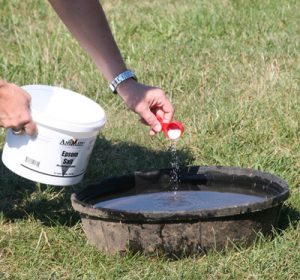Treating a Hoof Abscess
One of the most common causes of sudden-onset lameness in a horse is an abscess of the hoof. These occur when bacteria invade a horse’s hoof, and the horse becomes lame when the infection reaches the sensitive structures of the foot. Besides showing varying degrees of lameness, a horse with an abscess will be sensitive to hoof testers or percussion and may have lower leg swelling or an increased digital pulse. When it comes to treatment, the hoof abscess may erupt on its own, either from the sole of the hoof or at the coronary band. Otherwise, your vet will pare away the sole to locate and drain the site of infection.
Soaking the hoof several times a day will eventually cause an abscess to erupt and drain. However, some vets now advise against frequent soaking as it may weaken the hoof wall. Some horse owners instead choose to apply drawing agents, such as ichthamol or Epsom salts, directly to the hoof under a bandage.
The goal in the treatment of a horse’s hoof abscess is to draw out the infection and keep the area clean to prevent reinfection while the hoof heals. Once you have confirmed the diagnosis with your vet, follow the steps below to put your horse on the road to recovery.
  |
  Step 1: Mix Epsom salts in a bucket of warm water. Use enough salts to reach the point of saturation, where no more will dissolve. |
Step 4: Wrap the hoof in a diaper or sheet cotton. Secure the diaper by tightly wrapping it with elastic bandage. Cover the entire bandage with duct tape for durability. If your horse will be turned out or is prone to destroying bandages, you may want to use a hoof boot.
Click here for step-by-step instructions on bandaging a hoof. |
Your horse may be sound in as little as a couple of days. Once the abscess has drained, keeping the hoof protected from dirt and debris is the best way to avoid complications or reinfection. And of course, always consult your vet to help you decide the best course of action.
Further Reading on Treatment of Hoof Abscesses in Horses
◆ Hoof Abscesses and Puncture Wounds
◆ How to Manage and Treat a Hoof Abscess
◆ Causes of Equine Lameness: Foot Abscess
This article about treatment of hoof abscesses first appeared in Horse Illustrated magazine. Click here to subscribe!
Recent Posts
Barn Banter – Episode 30
Welcome to Barn Banter, the official podcast of Horse Illustrated. In Barn Banter episode 30, hosts Susan Friedland and Horse Illustrated…
ASPCA Right Horse Adoptable Horse of the Week: Lucille
Welcome to Horse Illustrated’s weekly installment of the Right Horse Adoptable Horse of the Week, offered in partnership with the…
Bed Sores in Horses
As you brush your horse’s lower legs, you spy something curious. There’s a little patch of hair that’s ruffled, like…
A Recap of Road to the Horse 2025
Road to the Horse is an exciting, unique colt-starting event, dedicated to changing people’s ideas and creating a better world…
2025 Defender Kentucky Three-Day Event: An Impressive List of Entries
Lexington, Ky. — Six of the world’s top 12 eventing riders, including World #1 Tom McEwen (GBR) and World #2…
2025 Defender Kentucky Three-Day Event
Stay up to date on the action from the 2025 Defender Kentucky Three-Day Event. Find information about the event, including…
View Comments
the wrap seems to be too high...keep it to just above the cornet band or you may have circulation issues.
Our vet showed us how to wrap it so it would come off easier. They are hard to get off. Good article!
Excellent article! :) Thank you, will print it off and keep it for reference as I have a horse who is very frequently getting abscesses. :)
Excellent. Thank you. I have a horse that is lame and it is a suspected abcess but it is not coming to a head. Currently the poultice is on - it is so hard to see him so lame and unsure how long he will be that way. This article has helped me better understand. He is under the care of a vet
The last photo showing the duct taped hoof should be removed. It is absolutely dangerous to have any tape or wrapping around the coronary band. There are plenty of ways to wrap a hoof without going above the coronary band.
This is the best information I have found on the Net. My vet didn't even offer this alternative. Many thanks.
Great advice!
I've been using an Epsom salts soak for years with perfect success in my commercial stable but liked the extra ideas you provide.
So, Jennifer, what other ways are there?
Excellent advice--and it worked!